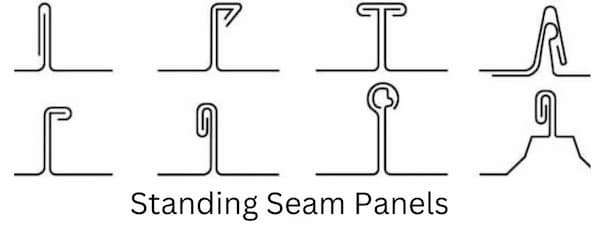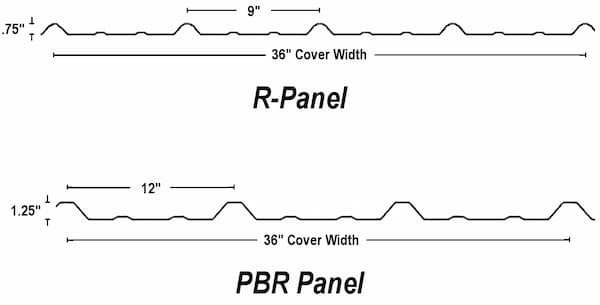Standing Seam Panels vs Screw-Down Metal Panels
Posted by Howie Scarboro - CEO Fall Protection Distributors, LLC on Apr 9th 2025
Standing Seam Panels vs Screw-Down Metal Panels
Let's dive into the modern metal roofs of today and talk about two popular options: premium standing seam roofs and the more budget-friendly screw-down (exposed fastener) systems. If you've ever been curious about what makes these roofs different or how to spot them in the wild, you're in for a treat! We're about to break it all down in this roofing face-off, digging into the stuff that matters: how much they'll set you back, how long they'll last, what they look like, and a few other tidbits. By the end, you'll have a solid grip on the best fit for you.

What Are Standing Seam and Screw-Down Metal Roofs?
Standing Seam Metal Roofs (Floating Standing Seam)
A standing seam metal roof features mostly flat panel valleys and raised interlocking seams, hiding the fasteners beneath. These concealed clips allow the panels to slide to accommodate thermal expansion. Standing seam panels are constructed from aluminum, steel, copper, or zinc to ensure long-term durability and performance.
Standing Seam Metal Roofs (Non-Floating Nailstrip)
Standing seam roofs are known for having hidden clips that secure the panels and allow for thermal expansion. However, nail strip standing seam panels have a nail flange that allows for mechanical fastening of the panels to the deck. The next panel that snaps over them hides these fasteners. Nailstrip panels are widespread in the industry as a low-cost alternative to floating standing seam roofs.
Nailstrip panels are a favorite of the DIY community because they don't require specialized equipment for installation. The long-term viability of a nailstrip roof system depends on the quality of the fasteners.

Screw-Down (Mechanically Fastened) Metal Roof Systems
Screw-down metal roofs (exposed fastener roofs) have exposed fasteners securing the panels to the decking or purlins. This more straightforward design makes them quick to install and widely available. Exposed fastener roofs are often seen on barns, sheds, or carports, where affordability trumps longevity or weatherproofing needs.

Standing Seam vs. Screw-Down: How Do They Compare?
Here's a head-to-head comparison of these two metal roofing systems based on the factors homeowners ask about most:
Cost: Which Metal Roof Fits Your Budget?
Screw-Down: Affordable upfront, ranging from $4 to $6 per square foot. The more straightforward materials and faster installation keep costs low.
Standing Seam roofs are more expensive, averaging $12 to $16 per square foot. Thicker metal, hidden fasteners, and skilled labor increase the initial cost. Nailstrip roof systems cost less and incur less installation labor than floating standing seam roofs.
Takeaway: Screw-down panels win for buyers with tight budgets, but standing seam's longevity often offsets the higher initial investment.
Durability: Which Panel Style Lasts Longer?
Screw-Down: 20-30 years with regular maintenance is a reasonable lifespan. Exposed screws can loosen or corrode over time, especially in harsh climates. Good maintenance and changing screws can help extend the life cycle of screw-down-style panels.
Standing Seam: It has a life span of 30-50 years (or up to 70 with proper care). Hidden fasteners and thicker metal make it a fortress against the elements.
Takeaway: Standing seam outshines screw-down for long-term reliability.
Maintenance: How Much Upkeep Do They Need?
Screw-Down: High maintenance. Thermal expansion can wallow out screws, requiring replacements every 5-10 years to prevent leaks.
Standing Seam panels are low maintenance. With no exposed fasteners, you'll primarily clear debris and occasionally check penetrations.
Takeaway: Standing seam saves you time and effort over decades.
Leak Resistance: Which Keeps Water Out?
Screw-Down: Vulnerable as washers degrade or screw back out, especially in overheated spaces where expansion is constant.
Standing Seam: Superior watertightness thanks to concealed fasteners and seams designed to flex without breaking seals.
Takeaway: Standing Seam is the proven leak-proof champion.
Aesthetics: Which Has The Cleaner Look?
Screw-Down: Functional but industrial, with visible screws creating a rugged, utilitarian vibe.
Standing Seam: Sleek roof systems with clean lines and no fasteners—perfect for modern homes or premium metals like copper.
Takeaway: Standing seam roofs have the best-finished look of all metal roofs. They are low maintenance and, due to the hidden fastener feature, have a much lower chance of water leaks.
Installation: What To Expect
Screw-Down: Installation with only essential tools and less expertise. DIY-friendly for many homeowners.
Standing Seam: Complex, requiring specialized equipment and trained pros, which hikes labor costs. Nailstrip panels don't use hidden clips; they screw directly down to the decking, saving time and money.
Takeaway: Installing screw-down metal roofing is more straightforward, but standing seam's precision pays off.
Oil Canning: Will It Warp?
Screw-Down: Rare, as multiple ribs and screws prevent waviness.
Standing Seam: This seam is susceptible to oil canning (cosmetic waviness) if panels are installed too tightly or pinned down with mechanical fasteners.
Takeaway: Screw-down avoids this aesthetic quirk.
How to Identify Your Metal Roof
Which type have you got? Here's how to tell standing seam and screw-down metal roofs apart:
Fasteners: Look for screws. Visible screws with rubber washers mean screw-down; no screws in sight means standing seam's hidden clips are at work.
Seams: The standing seam has tall, raised vertical ridges (1-3 inches), while the screw-down shows flatter, overlapping edges.
Appearance: Standing seam looks polished and seamless; screw-down has a grid-like screw pattern.
Rust Spots: Aging screw-down roofs may show rust around screws; standing seam stays pristine longer.
Spot these clues from the ground with binoculars or during a safe roof walk, and you'll know what you're working with.
Why It Matters: The SSRA1 and Standing Seam Roofs
Here's where it gets personal for your project. Our SSRA1 is a specialized seam anchor for standing seam metal roofs. Why? Standing seam roofs' raised seams and concealed fasteners demand a mounting solution that clamps securely without drilling holes or voiding warranties. The SSRA1 delivers—perfect for adding solar panels, snow guards, or other upgrades while keeping your roof intact.
Screw-down roofs, with their exposed screws and overlapping panels, don't pair with the SSRA1. If you've got a standing seam roof—or plan to install one—the SSRA1 is your ticket to enhancing functionality without compromise.
Which Metal Roof Is Right for You?
Choose Screw-Down If: You need a budget-friendly, quick-install option for a garage, barn, or unheated space. Just plan for regular screw checks to keep it leak-free.
Choose Standing Seam If you want a long-lasting, low-maintenance roof with premium looks for your home or business, especially over living spaces.
Both systems shine in the proper context. Screw-down offers affordability and simplicity; standing seam brings durability and elegance. Pros (and we) lean toward standing seam for residential roofing overheated areas—its expansion-friendly design and hidden fasteners make it a leak-resistant powerhouse.
Ready to Decide?
Are you thinking about investing in metal roofing? It's essential to understand various types of metal panels. Budget-friendly screw-down panels are more affordable than the stronger standing seam alternatives, which provide better performance and visual appeal.

